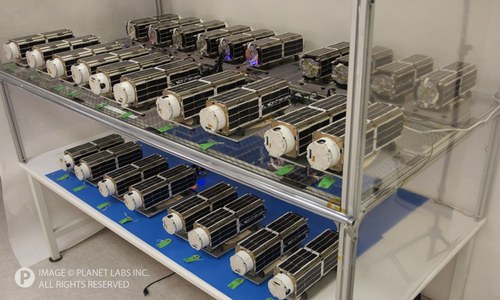
The 28 satellites of Flock 1, the first constellation of remote sensing satellites built by Planet Labs. The satellites will be launched on a Cygnus cargo spacecraft to the International Space Station in mid-December. (credit: Planet Labs)
Planet Labs, the San Francisco-based commercial remote sensing company that launched its first two satellites in April and exited from stealth mode in June, now has two more satellites in orbit. However, the company is now looking ahead to the launch next month of an entire constellation of small imaging satellites.
A Dnepr rocket launched Thursday from a Russian missile base carrying a payload of more than 30 small satellites. Included in that launch were Planet Labs’s Dove 3 and Dove 4 smallsats, spacecraft based on the CubeSat form factor, about 30 centimeters long by 10 by 10 centimeters. (The launch also carried the first satellite for another commercial remote sensing company: SkySat-1 for Skybox Imaging.)
“We contacted Dove 3 on the first pass,” Planet Labs co-founder and CEO Will Marshall said in a telephone interview Monday. Dove 4 hasn’t been deployed yet: it was launched inside another satellite, Unisat 5, and is slated to be ejected in the next few weeks, he said.
The two spacecraft have more “specific performance,” or capability per kilogram, than the Dove 1 and 2 satellites launched in April, he said. The two new satellites feature upgraded attitude control system for improved pointing, improved radios for faster data rates, upgraded hard drive space on the spacecraft, and an “in house build” of the spacecraft’s telescope. “The most magical thing about what we have here is we have so much capability per unit mass,” he said. “In terms of capability per unit mass, we’re way, way out there” compared to other, larger remote sensing satellites.
Planet Labs is now focusing on an even bigger launch: its first full-fledged constellation of satellites, dubbed “Flock 1.” The company has completed 28 satellites, all similar to Dove 3 and 4, and delivered them to the Wallops Flight Facility in Virginia earlier this month. Those satellites will be loaded into an Orbital Sciences Corporation Cygnus spacecraft that will be launched on an Antares rocket to the International Space Station in December.
Once at the ISS, the spacecraft will be deployed similar to launches of CubeSats from the station last week. The timing of the satellites has yet to be scheduled, Marshall said, but would likely be some time in January. The deployment of the satellites would also be phased to evenly distribute the satellites to provide global coverage, he said, although those details have also yet to be worked out.
A successful launch would mean that, counting the four Dove satellites, Planet Labs will have launched 32 satellites in less than a year. “We built these at an unprecedented rate,” Marshall said. “We now have more satellites built in this lab than we have employees.”
A successful deployment would give the company the largest remote sensing constellation in the world, and the potential benefits of access to frequently updated imagery from those satellites has attracted customer interest, he said. “We’ve had tremendous interest,” he said, declining to go into specific details about who has signed on. “We have quite a number of customers, and our investors are very pleased right now.”

Any idea the cost/price per sat to get to orbit ?
28 3Us in the same orbit – I thought each sat in a constellation needed dif orbit to provide the required coverage ?
I’m also wondering how long these smallsats will stay in orbit.